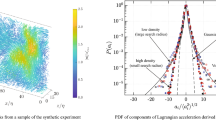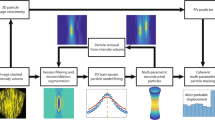Abstract
In this article, we present an experimental setup and data processing schemes for 3D scanning particle tracking velocimetry (SPTV), which expands on the classical 3D particle tracking velocimetry (PTV) through changes in the illumination, image acquisition and analysis. 3D PTV is a flexible flow measurement technique based on the processing of stereoscopic images of flow tracer particles. The technique allows obtaining Lagrangian flow information directly from measured 3D trajectories of individual particles. While for a classical PTV the entire region of interest is simultaneously illuminated and recorded, in SPTV the flow field is recorded by sequential tomographic high-speed imaging of the region of interest. The advantage of the presented method is a considerable increase in maximum feasible seeding density. Results are shown for an experiment in homogenous turbulence and compared with PTV. SPTV yielded an average 3,500 tracked particles per time step, which implies a significant enhancement of the spatial resolution for Lagrangian flow measurements.











Similar content being viewed by others
References
Brücker Ch (1996a) 3-D scanning-particle-image-velocimetry: technique and application to a spherical cap wake flow. Appl Sci Res 56(2–3):157–179
Brücker Ch (1996b) 3-D PIV via spatial correlation in a color-coded light-sheet. Exp Fluids 21:312–314
Brücker Ch (1997) 3-D scanning PIV applied to a air flow in a motored engine using digital high speed video. Meas Sci Technol 8:1480–1492
Chang T, Tatterson G (1983) Application of image processing to the analysis of three-dimensional flow fields. Opt Eng 23:283–287
Dracos Th (ed) (1996) Three-dimensional velocity and vorticity measuring and image analysis techniques. Dordrecht, Kluwer, Dordrecht, ISBN 0-7923-4256-9
Guezennec YG, Zhao Y, Gieseke T (1994) High speed 3-D scanning particle image velocimetry (3-D SPIV). Developments in laser techniques and applications to fluid mechanics. In: Adrian RJ et al (eds) Proceedings of the 7th international symposium, Lisbon, Portugal, pp 11–14
Hori T, Sakakibara J (2004) High-speed scanning stereoscopic PIV for 3D vorticity measurement in liquids. Meas Sci Technol 15:1067–1078
Kasagi N, Nishino K (1991) Probing turbulence with three-dimensional particle tracking velocimetry. Exp Therm Fluid Sci 4:601–612
Liberzon A, Guala M, Lüthi B, Kinzelbach W, Tsinober A (2005) Turbulence in dilute polymer solutions. Phys Fluids 17:031707
Lüthi B, Tsinober A, Kinzelbach W (2005) Lagrangian measurement of vorticity dynamics in turbulent flow. J Fluid Mech 528:87–118
Maas H-G (1992) Digitale Photogrammetrie in der dreidimensionalen Strömungsmesstechnik. Dissertation (ETH Zürich)
Maas H-G, Gruen D, Papantoniou D (1993) Particle tracking velocimetry in three-dimensional flows. Exp Fluids 15:133–146
Merkel GJ, Rys F, Rys P, Dracos Th (1998) Laser induced fluorescence tomography in passive and reactive scaler fields. Physical processes and chemical reactions in liquid flows. IAHR Monograph Series, pp 57–68
Nishino K, Kasagi N, Hirata M (1988) Three-dimensional particle tracking velocimetry based on automated image processing. ASME J Fluids Eng 111(4):384–391
Papantoniou D, Maas H-G (1990) Recent advances in 3-D particle tracking velocimetry. In: Proceedings of the 5th international symposium on the application of laser techniques in fluid mechanics, Lisbon, July 9–12
Racca R, Dewey J (1988) A method for automatic particle tracking in a three-dimensional flow field. Exp Fluids 6:25–32
Sakakibara J, Adrian RJ (1999) Whole field measurement of temperature in water using a two-color laser induced fluorescence. Exp Fluids 26:7–15
Su L, Dahm W (1996a) Scalar imaging velocimetry measurements of the velocity gradient tensor field in turbulent flows. I. Assessment of errors. Phys Fluids 8(7):1869–1882
Su L, Dahm W (1996b) Scalar imaging velocimetry measurements of the velocity gradient tensor field in turbulent flows. II. Experimental Results. Phys Fluids 8(7):1883–1906
Tsinober A (2001) An informal introduction to turbulence. Kluwer, Dordrecht, ISBN: 140200110X
Willneff J (2003) A spatio-temporal matching algorithm for 3D particle tracking velocimetry. Dissertation (ETH Zürich)
Yeung PK, Pope SB (1989) Lagrangian statistics from direct numerical simulations of isotropic turbulence. JFM 207:531–586
Acknowledgements
This work was supported by ETH Grant No. 0-20151-03.
Author information
Authors and Affiliations
Corresponding author
Rights and permissions
About this article
Cite this article
Hoyer, K., Holzner, M., Lüthi, B. et al. 3D scanning particle tracking velocimetry. Exp Fluids 39, 923–934 (2005). https://doi.org/10.1007/s00348-005-0031-7
Received:
Revised:
Accepted:
Published:
Issue Date:
DOI: https://doi.org/10.1007/s00348-005-0031-7




